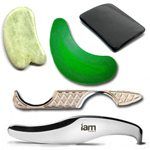 One of the major points that I wanted to get across in my new online program teaching you instrument-assisted soft tissue mobilization is that the tools do not need to be expensive to start using IASTM.
One of the major points that I wanted to get across in my new online program teaching you instrument-assisted soft tissue mobilization is that the tools do not need to be expensive to start using IASTM.
There are a wide variety of tools you can buy to perform IASTM, ranging from $5 to several thousand of dollars!
Luckily for you, it doesn’t have to be expensive to get started using IASTM! Don’t get me wrong, you absolutely get what you pay for with the different tools, however, price should not be an issue that limits your ability to start using IASTM. If you have $5, you can start performing IASTM.
Over the last several years, I have tried almost every IASTM tool on the market. There are many great ones. I am going to review several tools that I personally use and recommend. I will start from the cheapest to the most expensive and overview the pros and cons of each. When people are not sure IASTM is for them, I recommend starting with a cheap tool. Once you get the hang of it and see the many benefits, you’ll definitely want to upgrade.
Consider this article your resource for choosing the best IASTM tool.
Before you get too far into the below article, I should say that stainless steel tools are the best. People always ask me, “what is your favorite tool?” The tool I am currently recommending everyone purchase is the EDGE Tool by Erson Religioso. It’s great stainless steel quality, affordable, and very versatile. Plus, he’s offered my readers a special 10% discount off your entire order of everything in his store if you use promo code Reinold! He has many great tools, like his EDGE tool, cups, mobility bands, and even things like BFR units!
- Click here to buy the EDGE tool – My readers get a special 10% discount off your entire order if you use promo code Reinold
IASTM Tools
Buffalo Horn IASTM Tools

Jade IASTM tools

Bian Stone IASTM Tools

Polycarbonate IASTM Tools
The next class of tools takes a step up and now includes plastic or polycarbonate tools. These tools are more durable than all of the above tools and tend to be custom shaped based specifically for manual therapy. The shapes also tend to be larger, which is a good thing. I prefer polycarbonate tools over the above natural tools for their durability.

Stainless Steel IASTM Tools
Last but certainly not least are the stainless steel tools. Let’s get this out of the way first – stainless steel tools are by far the best tools for IASTM. I definitely feel everyone should have at least one stainless steel tool if they are serious about IASTM.
You can’t compare the feel, resonation, durability, or even weight. I like a tool with a little weight to it. Stainless isn’t perfect. My number one issue is often related to grip, as stainless steel can get VERY slippery during a session. That is why the tools I use tend to have some feature that enhances the grip. It is also easier to be aggressive with a stainless steel tool, so if you want to be gentle with someone, I would recommend using a different tool, at least initially.
There are two tools that you should highly consider.

- Click here to buy the EDGE tool – My readers get a special 10% discount off your entire order if you use promo code Reinold

Smart Tool offers many tools, including the VERY popular handlebar tool. There are also a lot of smaller tools designed to treat every body part. These tools are more expensive but are quality. If you are looking for an entire set of tools and a version of IASTM tools just like the most popular ones, this is for you. If you are not interested in the whole package, they sell the tools individually, so you can slowly build your set as your budget allows
Use coupon code REINOLD to save 10%:
What is the Best IASTM Tool?
I don’t think there is a clear winner for each and every person. If you treat a lot of athletes, you may want the Hawk Grip tools as they are larger and have a great variety. If you just treat hands and wrists all day, you may want a smaller tool. If you just have $100 to spend, the EDGE tool may be for you.
In all honestly, I use several tools together, and I bet you will too. Start with what looks best for you right now, even if just a piece of horn, and as you see the benefits of IASTM start to expand your collection. I have every tool on this list, and I actually use all of them based on my goals, different clients, and body parts.
If I had to pick one, I would definitely start with the EDGE Tool. It offers the most bang for the buck and is probably the clear winner in my mind for tools everyone should own.
- Click here to buy the EDGE tool – My readers get a special 10% discount off your entire order if you use promo code Reinold10
Learn How to Start Performing IASTM Today!
Erson Religioso and I’s online IASTM educational program will teach you everything you need to know to start using IASTM today! IASTM does not have to be complicated to learn or expensive to start using. Learn everything about IASTM, including its history, efficacy, tool options, different stroke patterns, basic techniques, advanced techniques, and how to integrate IASTM into your current manual therapy skills and treatment programs!




